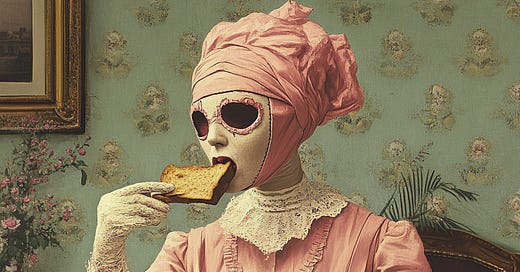Characters as Heightened Concepts
An idea explained by George Saunders, and demonstrated by Senaa Ahmad
IN GEORGE SAUNDER’S BOOK A Swim in a Pond in the Rain, he discusses the idea of characters as heightened concepts. The idea is to create characters that represent a unique bit of the human condition, but embody it in a more extreme way.
It’s a good technique for adding the depth of metaphor to a story, making it more meaningful.
I’m recently remind of Senaa Ahmad’s amazing, Pushcart-winning story from a few years back called, Let’s Play Dead. She executes the ‘character as heightened concept’ masterfully. She tells the tale of Anne vs Henry, but truly it is the story of Feminism vs the Patriarchy. Poor Anne is brutalized repeatedly by Henry, to the point of death. But she never truly dies.
We don’t need to stick around while her body crawls its way to her head and fits itself back together. Every excruciating inch of the stone floor is a personal coup, and every inch lasts the whole span of human history. It is slow. It is clumsy. The head falls off a couple of times. The body is floppy with atrophy. There is a lot of blood. She probably, definitely cries. It does not befit a queen.
*
He is reading the Saturday paper, still in his shirtsleeves, when she breezes in the next morning. The horizon of the paper lowers to the bridge of his nose. He is a man who wears his tension in the way of a beautifully tuned piano, and in this moment he vibrates at a bewildered middle octave.
“Anne,” he says, at an absolute loss.
“Henry,” she says, the picture of politeness.
She sits at the table. Not a hair out of place, not a leaky vein in sight. She butters her toast in four deft strokes. A servant steps out from the shadows to fill her teacup to the brim. It’s all very serene, domestic. If it takes her a few tries to put her toast back on the plate, or if he dabs his napkin with a little extra violence, well, who can say. She slurps her tea, which they both know he hates. He hoists his newspaper back up. Like this, they go on.
The power of the story doesn’t come from ever seeing Anne win, or even having a chance of winning. The story happens to the reader as we contemplate the ages of struggle. The character doesn’t change, but we do. She survives because we realize that we don’t want to see her die, and at some point begin to believe that she can never truly be killed.
Here’s how she did it: no one wants to see her die. Did you know it’s that easy, to stay alive?
When you die, you should tell all the dead girls.
The metaphor makes it meaningful. If you just read it literally, it would be a confusing mess.
My takeaway idea from this is to write a Coming of Age story that shows a character, perhaps a young man, at different points in time enduring the Rites of Passage of that era. He would represent the progress of manhood, or manliness.🙭





